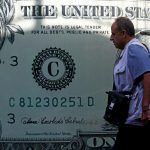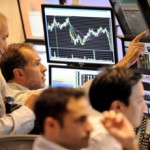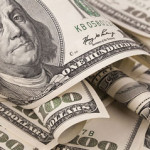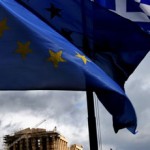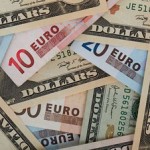ECB Buying Starts New Era for Bonds, Euro
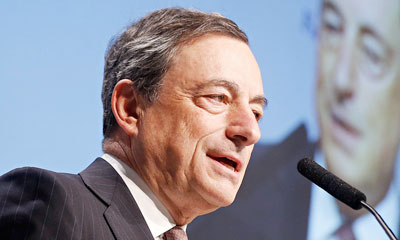
Currency heads toward parity with dollar; paying to hold debt
The arrival of the European Central Bank’s huge bond-buying plan Monday is forcing investors to prepare for the once unthinkable: paying to hold debt issued by the eurozone’s one-time trouble spots—even countries that have recently relied on financial bailouts to stay afloat.
What is more, the euro is sinking toward the point that it trades on a one-to-one basis with the dollar. Both trends are already in play.
Weighing a super-accommodative ECB, which hopes to rekindle the eurozone economy and dodge deflationary stresses with a €60 billion-a-month ($65 billion) bond-buying program, against a U.S. Federal Reserve that is preparing to raise its interest rates as early as June, investors have fled the euro.
Since last summer, the euro has shed more than a fifth of its value against the greenback.
“It’s a very clear divergence of monetary policy and we are still very positive on the dollar against the euro,” said Andrew Wilson, chief executive officer for Europe at Goldman Sachs Asset Management, which has assets of more than $950 billion under management.
On Friday, the euro lurched lower again, dropping as far as $1.0839, its lowest point since 2003, before inching up to end the day at $1.0843. Additional pressure came from the U.S., with better-than-expected news about employment teeing up a possible U.S. rate rise as soon as this summer. If current trends stay in place, the euro could soon fetch $1.
“A move down to parity looks realistic,” said Adrian Owens, a currency-fund manager at Swiss investment firm GAM who manages just over $3 billion in assets. “The only question is whether we get there in three to four months or whether it takes 18 months.”
The euro was last at parity against the dollar more than 12 years ago, in November 2002. In July 2008, it hit its all-time high of just over $1.60.
Even if euro-zone data paint a brightening picture, the ECB’s bond buying will keep a lid on interest rates, keeping pressure on the currency.
A weaker euro is a gift for the currency bloc, as it can support economic growth by enhancing demand for exports. It also lifts import prices, which could help add to inflation, which has been persistently below the ECB’s target. ECB President Mario Draghi cited the euro’s plunge as a reason for cheer at his regular news conference Friday.
Of course, there are some who think the euro has room to rise, especially because the ECB’s bond buys have been well-flagged in advance. Most of the expectations for the euro’s fall have already been baked into the cake, they say.
“We are getting very close to a turning point both on the euro and on rates,” said Aurelija Augulyte, a strategist at Nordea . “I want to go long the euro versus the dollar now,” she said, referring to a bet that the euro will rise.
Still, bond markets have reacted strongly to the ECB’s new stance.
Around a quarter of government bonds in the eurozone now trade with negative yields, which means that investors effectively pay to hold them.
So far, the subzero trend is confined to Europe’s so-called core of the most financially stable nations. German five-year government-bond yields, for example, were at negative 0.06% on Friday. Finland in February became the first nation in the region to pay a negative yield—in effect, asking investors to pay to hold its bonds—on five-year debt sold at auction.
But now the allure of ultralow rates is stretching to new parts of the euro area. Some investors think countries such as Spain, Italy and even Portugal, which was bailed out in 2011, could join the low-yield club.
Yields on 10-year bonds issued by all three countries dipped to record lows significantly below 2% on Friday—a turnaround from the peak of the eurozone crisis, when Portugal’s 10-year bond yield surpassed 15%.
“We could even see the two-year Spanish, Portuguese and Italian bond yields falling below zero in coming months,” said Azad Zangana, a European economist at Schroders , which has around £300 billion ($451 billion) of assets under management.
Nick Gartside, chief investment officer for fixed income at J.P. Morgan Asset Management, said, “It is only a matter of time” for yields to fall to such levels. “We’re still big buyers of debt in those countries.” Mr. Gartside’s firm has $1.7 trillion under management. Bond yields fall when prices rise.
In announcing the details of the bond-buying plan, Mr. Draghi pledged that the bank would buy debt even with yields less than zero as part of its program to boost inflation and economic growth, so long as those yields weren’t below the ECB’s deposit rate of negative 0.2%. For some, anything yielding more than that is a clear buy.
Short-dated Irish bond yields are already fluctuating around zero yield, and Spanish two-year bonds are yielding just 0.08%.
Traders and investors often position themselves in advance for widely anticipated shifts in monetary policy, pulling back once details are released, but in the case of the ECB’s bond-buying program, that pullback hasn’t materialized.
Alberto Gallo, head of macro credit research at Royal Bank of Scotland , said the restriction of only buying debt yielding more than negative 0.2% will likely generate particular demand for long-term debt in southern Europe, “since many core countries already trade very close to the no-buy zone.”
Source: WSJ – Currency heads toward parity with dollar; paying to hold debt









